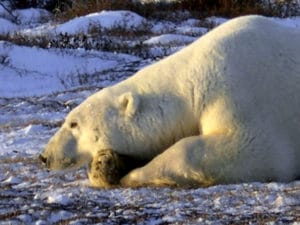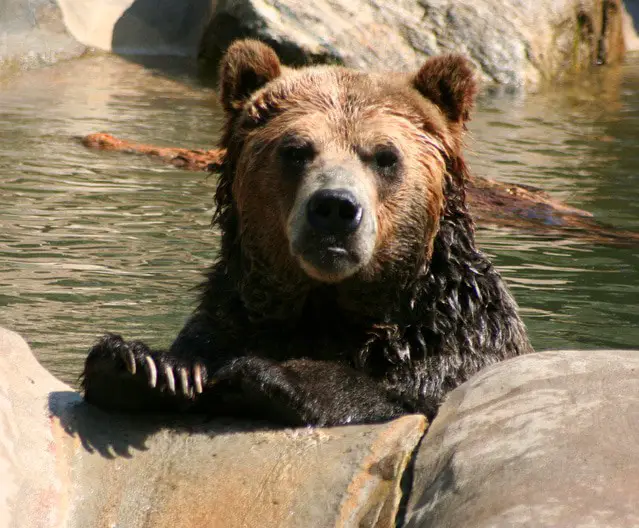
The great outdoors have so much to offer, but the most beautiful places are often among the most wild and that means being prepared for the worst like surviving a bear attack.
While this won’t be an issue in many places, if you are heading into bear country you definitely want to be prepared for the worst case scenario.
A little knowledge and preparation can go a long way to preventing a worse case scenario with a bear attack, no matter what type of bear you end up having to deal with. Read on to learn more about this very important topic so you can practice all the most important points in bear safety the next time you are out and about in bear country.
Table of Contents
Bear Attack Prevention Is Most Important
The best way to survive a bear attack is to avoid being in one to begin with. Obviously no one goes out looking to get mauled by wild bears, and yet there are so many hikers, campers, and other outdoor enthusiasts who don’t do their homework and don’t use common safety gear and practices to make it less likely for an unfortunate and potentially fatal surprise encounter.
This means starting out with the right equipment and understanding some basics about how to handle yourself in the wilderness. Preparing yourself properly in order to avoid any potential issues starts with having the right equipment which in this case means bear whistles and bear bells.
The bells can be attached to the belt and make noise with your natural walking. While your instinct is often to be quiet out in nature, the truth is that bears want to generally avoid people and the worst thing that can happen is to actually surprise them.
This means that sound from walking is going to be likely to keep them away from you, and having a whistle to use occasionally through thick brush or really desolate areas can also help make sure big wildlife know you are there and you don’t get attacked from startling them.
Even while hiking, this is best done in a group as opposed to solo, as a bear or bears are less likely to approach a group. Talking is also important, which is counter-intuitive for many people who learned to be quiet and enjoy nature while hiking but in bear country being talkative, occasionally yelling “Hi, bear!” and making noise is actually pretty critical to increase your chances of not having an unexpected run-in.
There are some arguments over whether or not bear whistles work, as this study shows, but making noise and letting predators like bears that are nearby know you are there, and know you are human and not conventional prey, is an extremely important part of preventing bear attacks on humans. You don’t want to be on the receiving end of that!
If you are going to be camping overnight, it’s important to have bear canisters to store your food. This not only helps keep any attractive smells from getting out, but it also helps to prevent attracting bears towards you. Canisters protect your food and minimize the chances of a confrontation, so don’t skimp on this piece equipment if you’re going to be experiencing overnight camping! These steps are how you avoid a bear attack.
Be Prepared for Bears
Being prepared for potential bear encounters in an area involves a variety of different things. You will want to have the right equipment, information on local bears, and material for preventing bear attacks as well as first aid materials to treat injuries in a worst case scenario. The first thing you need is local information. What type of bears are in the area? The way you respond to black bears, grizzly/brown bears, or polar bears are all very different. You need to know how to act if you run into any of the bears you find in the area you are camping in or hiking through!
Second, you need to know basics like trying to avoid hiking at dawn/dusk when bears tend to be especially active and might not notice you as much or being aware of your surroundings (leave the iPod headphones at home). Even taking really basic steps makes a big difference, but what about surviving an actual bear attack?
Bear Spray
You definitely don’t want to go through bear country without having a great can of bear spray in a belt holster, ready to be drawn out at a moment’s notice. There have been multiple studies on the topic and those studies are clear: bear spray is better than guns for the majority of individuals who are going to be out and about.
If you’re not an absolute crack shot then there’s no question the spray is better than a firearm, and even if you are a crack shot that’s no guarantee that in an actual situation with a charging bear that you would be able to act calmly and that a firearm would be effective.
You want to be carrying bear deterrent spray on you at all times. When a bear attacks, you want to flip off any safety cap, then as the charging bear approaches you want to spray so a cloud forms 20 to 30 feet away (depends on wind and the designed spray range of the spray). That cloud between you and the bear is going to be incredibly unpleasant for the bear and will send them running off in non-lethal pain well over 99% of the time.
Our Video on What You Need to Know about Bear Spray
Carry it, know how to use it, and you should even consider having an extra can or two you practice with (not spraying people or animals, but a really open area or backyard on non-windy day, etc) so you are comfortable using it.
What to Do if You Encounter a Bear
First of all, don’t stare. Just like we discussed in our article on proper self defense against animals, staring an animal down is seen as a threatening move and can further incite a charge. Never run. Bears are natural predators and if you run their instincts are going to make them chase, even if their earlier charges were just meant to be warning charges, aka “fake charges.”
You want to stand still, not giving a reason to appear threatening, but also talking loudly, your voice tells the bear that you’re not normal prey, and hopefully this will help the bear decide to wander off instead of charging forward. If this isn’t the case, it’s time to go for the bear spray.

There’s no question that proper use of bear spray is crucial to stop an attack dead in its tracks. If the bear manages to close within ten feet before you get the can drawn, then by all means aim for the eyes and nose in the same way you would use normal pepper spray on a human attacker.
However, ideally you want to have the can out early enough that as the bear charges you can spray forward into a fog/cloud 20 or 30 feet away from you.
That cloud is going to be absolute torture to a bear that can smell blood up to 20 miles and has senses many hundreds of times more advanced that a person’s.
You don’t want to use the spray when the bear is too far away, but as it gets closer or prepares for another charge, creating that cloudy fog of spray while standing relatively still, yelling out, and not making direct eye contact is critical to driving them off.
This will work around 99% of the time and end the confrontation on the spot. But what happens if you get caught by surprise, you’re in that unlucky 1%, or you for some reason get caught without? Then you need to know what type of bear you are facing to know what to do next.

Black Bears
Black bears are generally considered the least likely to attack and are known for being most easily scared off without a serious confrontation. However sometimes in places where there is a lot of human activity they can lose their fear, get used to finding scraps or food off of people, or if you surprise a mother with cubs then all bets are off.
While most people think of dropping and playing dead when a bear attacks, that is only for brown bears (which include grizzly bears and Kodiak grizzlies as separate sub-species). Proper black bear defense is actually the opposite. Brown bears might kill prey and then wander off or look for more before coming back. Black bears gorge themselves immediately after taking down prey.
That means the only response to a black bear attack is to fight like hell, and use whatever you have in reach. If you have bear spray, bring it out and unload point blank in its mouth, nose, and eyes. Yeah, you’re going to experience pain on a level most people can’t comprehend, and it’s going to last a long time, but it’s better than dying from being mauled and eaten.
If you have a gun, fire repeatedly into its neck and face. If you’re out of bullets keep beating on its eyes with the butt of your pistol. If you don’t have bear spray or gun, but have a knife, a stick, a stone, keys, anything, jab for its eyes. Go for the most sensitive spots and don’t give up.
No matter how badly hurt you are if a black bear is attacking, you will die if you stop fighting back. You have to make yourself as problematic a prey as possible. While difficult, black bears can be fought off with enough vicious force. That’s the only chance for surviving a close up (and otherwise fatal) attack with a black bear, as extremely rare as they are (this Wikipedia list shows there are generally 1-2 fatal black bear attacks a year in all of North America and often times there are red flags from people who ran, cooked at their campsite, etc).

Brown/Grizzly Bears
When you’re dealing with a grizzly bear encounter, it’s important to understand the nature of these bears if you’re going to survive a worst case scenario confrontation. Brown bears of all type tend to be a little bit more aggressive, but most of the time they still want to avoid confrontation if at all possible.
The first step is not to run. First of all, prey runs. When you’re dealing with a top level predator like a bear, you don’t want to look like prey.
The second part to why that’s a bad idea comes with knowing how fast bears run. Grizzly bears run up to 30 mph, can do so for far longer than humans can run at full speed, and contrary to a popular wives’ tale, they can run downhill just fine.
If bear spray fails, then you want to play dead, making a ball out of your body and covering your neck and head. If you have a backpack, keep it on! That could prove vital protection between you and the bear. Stay still and play dead. This includes not fighting, not making noises, just being still.
When the bear stops attacking, and even when it first wanders off, you need to stay curled for several minutes longer. Many times a bear will stay close by to make sure the “kill” is really dead and that the prey isn’t fooling it. During this time if it sees you get up and move, it is going to attack again.
Give it a little bit of time, and often in this situation if the mother charged because cubs were close by she will take this opportunity to make sure you’re not getting up, then go follow to move the cubs away. That’s the time you can get up, treat your wounds, and then get out and get help.
Having a first aid kit on you might be the difference between life and death. You won’t take the time to wrap yourself up perfectly, and you don’t want to spend time sitting down doing so, but patch up the worst to slow or stop the bleeding and get moving to safety.
Then there’s this tough s.o.b. who survived the grizzly attack in the wild while hunting, bandaged himself up, walked back for treatment, and documented the attack and after process. You know, no biggie in Montana.

Polar Bears
If a polar bear comes your way…pray? The question of does bear spray work on polar bears is a more difficult one to answer since this type of deterrent is generally tested on black and brown bears and not polar bears. While slower when charging, polar bears are also much bigger and are the apex predator among bears.
Polar bears also don’t have the same aversion to people as other bears do – in part because food can be more scarce. If you’re meat and moving, a polar bear is far more likely to be interested.
There is a general belief that bear mace can work on polar bears, but no one is willing to commit to it the same way as with smaller brown and black bears. Up in the north being out in polar bear country means you should be with a group, with a guide, and with one or multiple high powered rifles. That’s a situation where going with the firearm might be the right choice over the bear spray – or you should carry both.
In Conclusion
Although rare, you never want to be on the wrong end of a surprised or angry bear. However, if you find yourself the tips here you will be more likely to prevent a bear attack from happening in the first place and if you do find yourself in a bad situation, use that bear spray, identify the type of bear you’re dealing with, and if you do that you will have a much better chance of making it out alive.
If you want to learn more, consider reading this great article on bear safety tips to learn more.

